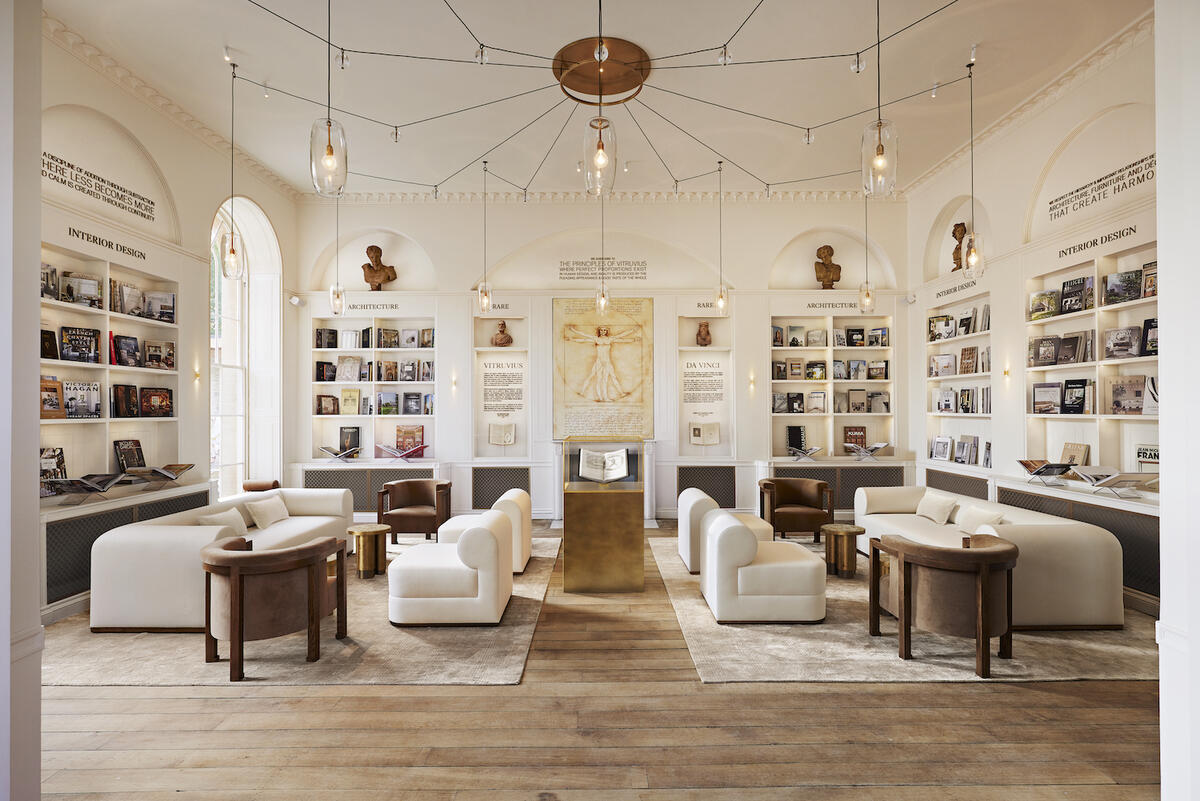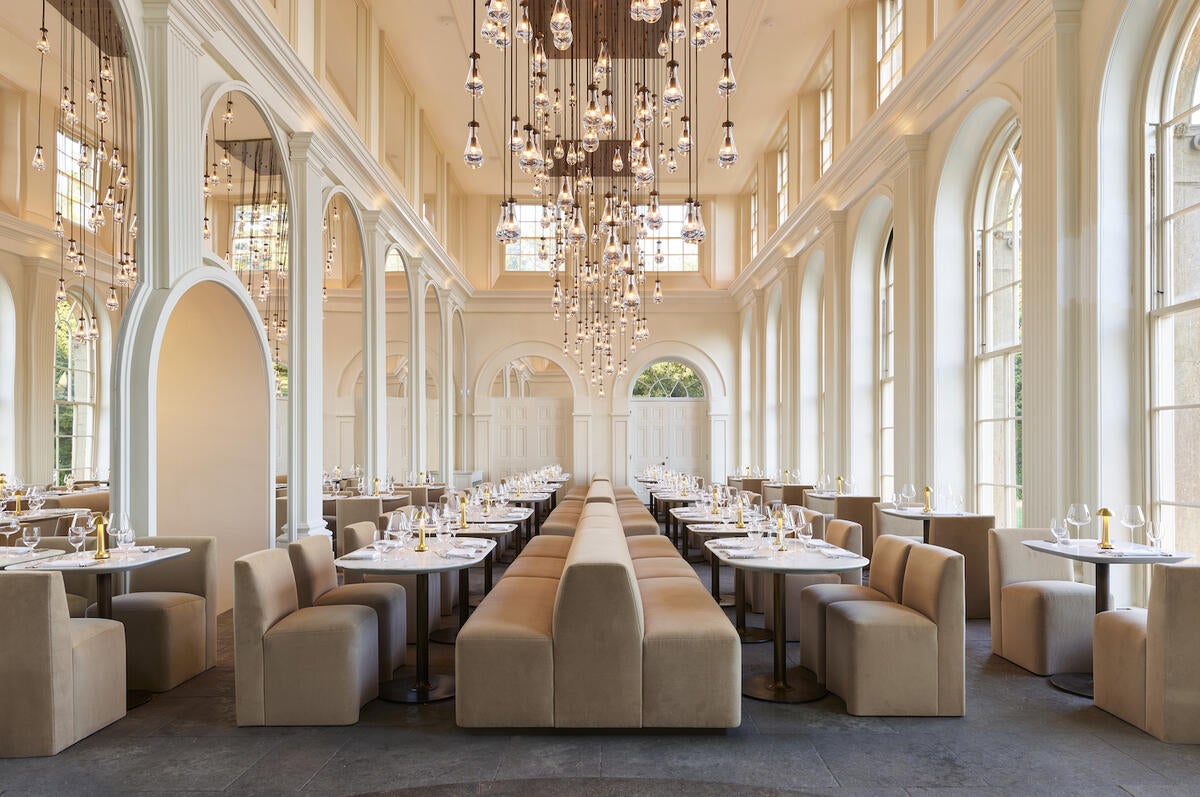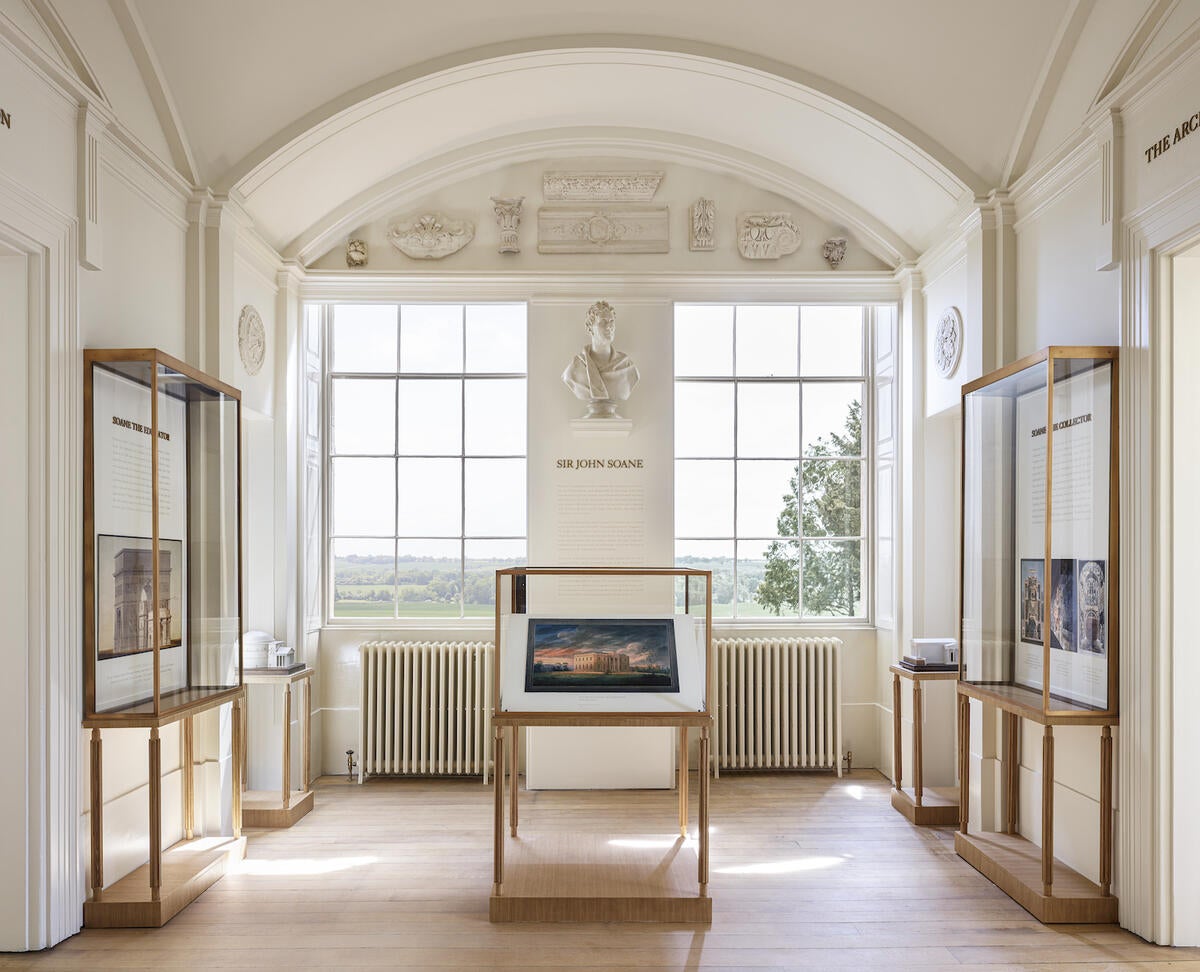Gary Friedman said he wanted beautiful weather to unveil RH England and he got it. It was a dreamy June evening in the Cotswolds, all indigo skies and soft yellow light, when a crowd of designers, celebrities, models and one Business of Home editor was invited on to the grounds of Aynho Park, the 73-acre country estate that serves as the brand’s first international location. Despite that, one got the feeling that Friedman, RH’s famously detail-obsessed CEO, would have swept the few stray clouds from the horizon if he could.
It would technically be accurate to say the reveal of RH England was a party to celebrate the opening of a furniture store, but only in the same way that game seven of the World Series is technically a ball game. Most furniture stores aren’t situated in 17th-century manors, with grounds populated by a herd of white deer (Europe’s largest, according to a press release). Most furniture stores do not feature wine lounges, tea salons and a library housing a rare early translation of Vitruvius. Nor do most furniture stores hire Idris Elba to DJ their opening-night celebrations.
In scale and ambition, RH England is enormously, Americanly bold. In that, it fits neatly into Friedman’s portfolio of famously grand stateside galleries, often housed in refurbished landmark buildings. But the opening of RH England is markedly different from another reclaimed suburban palace in a secondary U.S. market. Across the pond, the stakes are higher.
Since taking over as CEO in 2001, Friedman has been on an arduous quest to transform what was once a purveyor of knickknacks and antique doorknobs into a genuine luxury brand. The journey—he refers to it as “climbing the luxury mountain”—has a destination: Joining the ranks of Hermès, Louis Vuitton, Cartier and the like at the summit to become a company whose very name commands respect, reverence and 25 percent operating margins.
There’s plenty of money to be made if Friedman can pull it off. But the specificity of this particular goal feels like something more than a coldly rational business objective. In his quarterly letters to investors, Friedman often frames RH as a scrappy upstart looking to compete against the snooty old-world luxury establishment: “We are not from the neighborhood. We are not invited to their parties. They don’t really want us to make that climb,” and the like. There’s a point to prove here.

To prove it, it won’t be enough to win the hearts and wallets of affluent Americans; Friedman will also have to play in Europe, on the home turf of luxury’s biggest names. Over the next two years, RH is scheduled to unveil a spate of galleries—in London; Paris; Madrid; Milan; Düsseldorf, Germany; and Brussels. But RH England, set in the rolling English countryside, 75 miles from London, is the first.
In that regard, Aynho Park will be judged less by traditional retail metrics and more as a symbol. This is not so much a store as a physical manifestation of Friedman’s desire to scale the final summit of his mountain. All of which can help explain why RH, already famous for its extravagance, pulled out all the stops—both for the property itself and for its unveiling party, which, with its liberally poured champagne, roving photographers and parade of black town cars dropping off stylish notables, felt like a scene from Succession.
RH’s adventure abroad carries incredible risk. In addition to buying and refurbishing an enormous British country estate, the brand has already signed huge leases in some of Europe’s priciest retail neighborhoods—all before selling a stick of furniture. This is not a cautious scouting effort, but a full-scale invasion. If it flops, there will be consequences. An investor told me plainly: “If Gary is wrong about all this Europe stuff, he’s going to have problems.”
So it was reasonable to wonder that evening whether all of us—from Idris Elba to Europe’s largest herd of white deer—were gathered in the English countryside to kick off Friedman’s Normandy Beach or his Waterloo.
You do not have to dig too deep to find skepticism about RH England. Almost since the project was first announced in 2019, it has been met with raised eyebrows. As more details emerged—a restored manor two hours outside of central London?—the eyebrows only got higher. In researching this article, I spoke with investors, journalists, consultants, interior designers, competitors and fans alike, nearly all of whom expressed at least some hesitation about RH’s chances in the U.K.
Friedman seems to relish the skepticism—you can’t prove the doubters wrong if you don’t have doubters—and brushing aside sniping has become a regular fixture on his quarterly earnings calls. Acknowledging (and discounting) skepticism about RH England has become so integral to the project that it’s literally written on the wall. In the entryway to Aynho, one of the first things visitors will see, after a taxidermied “unicorn,” is a nod to the haters, rendered in gold lettering:
RH England. A celebration of history, design, food & wine, born of curiosity, creativity, and what some may call insanity.
“Insanity” is a bit strong, but there’s plenty of doubt in the air, most of which falls into two camps. The first is that the product is not right. RH’s famously epic 20-foot sectionals, which fit so neatly into a Dallas living room, will be tough to squeeze into an efficient London flat—plus, the brand’s predilection for sleek, self-serious contemporary style will be at odds with the English love of whimsy, color, coziness and clutter. Or so the thinking goes.
If Aynho Park made any concession to the size and style of the average English home, it was difficult to detect. The brand’s signature beige-white-and-gray palette dominated the upstairs rooms, which showcased its collections in bedroom, living room and dining room settings. None of it was particularly small—one vignette featured an enormous sofa in doe-brown velvet—nor classically English in style. What RH England feels most like is RH.
But as brand champions have long argued, most of the company’s assortment can be scaled down to fit smaller floor plans. New York, after all, is a famously space-challenged market, but RH’s expansive Meatpacking District flagship has plenty of enormous sofas on display and does a brisk business regardless. And while RH doesn’t sell toile or weathered chesterfields, the idea that English style is all old-world eclecticism has always been a little silly. There is a market for RH’s look in England.

The second critique is that the location is not right—that, no matter how many tea lounges Aynho Park can boast, it’s simply too remote a location to gain meaningful traction. “When we talk about destination stores in the U.K. we tend to think of shops that will bring people in from maybe 20 to 30 miles away at a stretch,” says Richard de Melim, editor in chief of the U.K. trade publication The Furnishing Report, echoing a common sentiment. “Beyond the initial interest in the launch, it will certainly be a challenge for RH to get significant footfall through the doors.”
Friedman has a ready answer there too. As early as 2021, he was making the case on Mad Money that Aynho Park was less about foot traffic than brand value. “It’s not even how many people go to the gallery,” he told Jim Cramer. “It’s going to be about the 40 to 50 million people who see it on our website. We’ll put it on the cover of our sourcebook and mail it to millions of people.”
In that way, RH England is a bit of a Rorschach test. Aynho Park does look breathtaking in photos. And as Friedman has long promised, a visit was immensely pleasurable—at least to this editor on a warm night in June. But the critics, too, are right to question whether, on a freezing Tuesday in February, the site can entice enough visitors to justify the expense of not one but three on-site restaurants.
Threaded through the more strategic critiques of RH’s chances in England is something a little more ephemeral. People in and around the British design scene often homed in on the idea that the brand—with its unapologetic ambition and naked grandeur—is out of step with a famously understated English national character. Even the British pronunciation of “RH” (they say, “R Haitch,” not “R Aitch”) felt a little off.
Clearly, a market opportunity exists for something like RH in England. At the high end, the British design industry is fragmented, lacking a dominant player to gobble up market share—as RH continues to do stateside. But there’s a bit of alchemy to the reason why one U.S. company translates in the U.K. and another does not. Why is it, for example, that Walmart has famously flopped there, while Costco continues to expand? Wendy’s has never made a big dent in England, but Five Guys is ubiquitous. Most of the English design industry insiders I spoke to seemed skeptical that RH had the right mix to connect. “Brash” was the word that kept popping up.
Of course, RH might not need to appeal to the design industry at all, only to its clientele—and if anecdotal evidence is any indication, there’s interest there. At the opening night party, more than one English couple could be seen sit-testing the enormous sectional with approval, and I met a luxury brand consultant who told me she had written Friedman personally several times, asking him to bring RH across the pond.
Several observers also pointed out that the audience for RH England doesn’t necessarily have to be British. London is a famously global city. By some accounts, more than 40 percent of its prime real estate is held by foreign internationals. And while Aynho Park is a two-hour drive from London, it’s only 15 minutes away from Bicester Village—a mall for designer brands that, after Buckingham Palace, is the second-most-visited destination for Chinese tourists in England. Even if Friedman’s Cotswolds manor fails to connect with a local audience, it might not need one.
The opening of RH England comes at a strange time for RH, the company. When plans for the brand’s international expansion first began to trickle out, it was 2019, the stock was trading at a then-high of $200 a share, and Friedman’s bet on huge galleries and prestige restaurants was paying off. Warren Buffett began snapping up millions of shares, and overseas expansion looked like a natural next play for a brand on a roll.
It looked even better in the highs of the Covid home boom, as RH produced record profits, record margins, and the stock climbed to dizzying highs, tipping over $700 a share. During this period, Friedman’s team continued to scout locations in Europe, lock down leases and push Aynho Park toward completion.
Then came Russia’s invasion of Ukraine, the unofficial end of the pandemic windfall for home retailers. RH was still posting good numbers, but the stock had already been tumbling, and over the past year it eventually settled back down to the mid $200s—roughly where it had been pre-Covid. This spring, it slipped out that Warren Buffett had unloaded his stake.
It would be wrong to say that RH is a troubled brand, but it clearly is one in transition. The company saw revenue drop by 23 percent this quarter, while investors have been making noise about competitor Arhaus gobbling up market share at RH’s lower end. On a recent earnings call, Friedman—never shy about getting real with analysts—suggested that RH had been “arrogant” about raising prices in the home boom and would be marking down its product.
All of that recent history, plus a stumbling market for luxury housing—to say nothing of a European economy that has been hit harder than ours—changes the context of RH England and what comes next. The mood of the market has shifted toward austerity, and investors will likely be eyeing line items like Aynho Park and its Gatsby-esque debut with scrutiny.
Friedman seemed to acknowledge as much at the party. In a toast, he jokingly called out a pair of analysts in the audience, then riffed on Wall Street’s numbers fixation in contrast to his team’s love of creation. Later on in the evening, I sat in the gallery’s open-air restaurant next to two investors and briefly discussed the outlook for RH England. They seemed torn between enjoying the atmosphere, wine and wood-fired pizza—all excellent—and fretting about how much all the free food would cut into the brand’s margins.
There is a raw business case to be made for the extravagance of Aynho Park. If RH is going to be a genuine luxury brand, it has to act like one, and the one thing a luxury company can’t afford to be is cheap. “Historically, European luxury brands have traded at a premium to a lot of U.S. brands. If RH can successfully expand to Europe, the valuation is going to increase—they can claim, ‘Hey, we actually are a global luxury furniture company,’” says Max Rakhlenko, an analyst who covers RH for American investment bank TD Cowen.

Ultimately, it may not matter if RH loses money in Europe. If the brand gets the luxury halo, it can cash in on it elsewhere (Australia is the next international target) and reap the benefits for years to come.
Veteran retail journalist Warren Shoulberg, who has closely followed the brand’s ups and downs over the decades, is bullish on Friedman’s chances—if for no other reason than he’s proved the doubters wrong too many times. “When he started opening up big stores with restaurants in them, everyone said it was crazy, and then it worked,” says Shoulberg. “I suspect what will happen here is that he’ll open up big stores with restaurants in them in Europe, everyone will say it’s crazy, and then it will work.”
And if investors continue to grumble at the expense? “Gary has been remarkably good at not giving a damn about what anyone thinks,” says Shoulberg. Some of that is probably pure personality: Friedman, who famously walked away from a lucrative job at Williams-Sonoma to take over the then-struggling Restoration Hardware, is known to embrace risk. But it’s structural too. With more than 3 million shares to his name, Friedman is RH’s biggest single shareholder.
In other words, he has leverage and time. Meanwhile, the rest of us can blindly guess about the future. After returning to New York, I took a call with an investor who holds a significant position in RH stock, hoping that he could offer up the killer insight that would foretell the brand’s international future. Halfway through the conversation, I realized he was hoping to get the same from me. The simple truth: As Friedman often says, no one has tried this before. So it follows that no one really knows if it will work.
If it does, the first step for RH is getting the word out. In spite of its ubiquity in the States, the brand is an unknown quantity to most Brits. Even many designers have simply never heard of it. In Oxford, I dropped into a home goods shop that sells brands like Ligne Roset and B&B Italia—the very companies Friedman is hoping to disrupt—and when I asked, the manager took pains to write down “RH” on a notepad and told me she would Google it later.
To that end, a statement location, a herd of white deer, a wine lounge and a library of rare design manuscripts feel less like insanity and more like a savvy first step. Same goes for a celebrity-studded opening-night party covered dutifully by British tabloids the following day. (Among the faces I spotted: Sydney Sweeney, Zoe Saldaña, Regé-Jean Page, Ellen DeGeneres and Portia de Rossi.)
As the night wore on, DeGeneres hopped onstage to give Idris Elba an assist on the turntables, and the crowd reveled, champagne and vesper martinis in hand. In the background, a brilliantly full moon shone down on the valley, leading me to wonder if Friedman had timed the party to the lunar cycle. The herd of white deer, which had spent most of the party grazing in the distance, finally ventured up to the edge of the lawn to see what the fuss was about.
Earlier, I had been standing next to Alexa Hampton in the gallery’s jewel-box library. As we peered over an 18th-century manuscript cataloging the work of Thomas Chippendale, I happened to look up to see a photographer snapping a shot of supermodel Jourdan Dunn just outside the window. It was a moment that combined design, history and glamour—everything RH is trying to evoke—all in one tableau. Friedman himself couldn’t have planned it. Except, in a way, he had.
Homepage image: The grounds of Aynho Park, the 73-acre country estate that serves as the RH’s first international location | Courtesy of RH



























